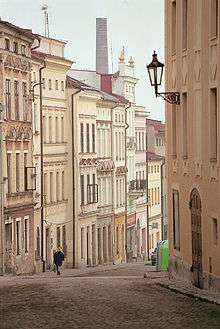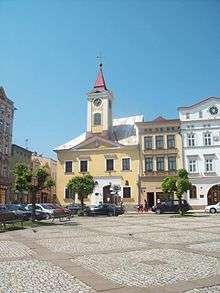Broumov
| Broumov | |||
| Town | |||
 Peace Square with Marian Column | |||
|
|||
| Country | Czech Republic | ||
|---|---|---|---|
| Region | Hradec Králové | ||
| District | Náchod | ||
| Commune | Broumov | ||
| Elevation | 395 m (1,296 ft) | ||
| Coordinates | CZ 50°35′18″N 16°19′48″E / 50.58833°N 16.33000°ECoordinates: CZ 50°35′18″N 16°19′48″E / 50.58833°N 16.33000°E | ||
| Area | 22.26 km2 (8.59 sq mi) | ||
| Population | 7,783 (1.1.2012) | ||
| Density | 350/km2 (906/sq mi) | ||
| First mentioned | 1256 | ||
| Mayor | Milan Kotrnec | ||
| Timezone | CET (UTC+1) | ||
| - summer (DST) | CEST (UTC+2) | ||
| Postal code | 549 83 - 550 01 | ||
  Location in the Czech Republic
| |||
| Wikimedia Commons: Broumov | |||
| Statistics: statnisprava.cz | |||
| Website: www | |||
Broumov (Czech pronunciation: [ˈbrou̯mof]; German: Braunau) is a town in the Czech Republic, in the Náchod District of the Hradec Králové Region, near the border with Poland.
Geography
The municipality is located on the small Stěnava River in the northeast of Bohemia, about halfway between Náchod in the southwest and Polish Wałbrzych in the north. It is the centre of the Broumovská vrchovina area of the Central Sudetes range, along with the adjacent Adršpach-Teplice Rocks a protected area popular with mountain climbers.
History
Broumov was first mentioned as a town in 1256. The Přemyslid king Ottokar I of Bohemia had granted the remote area around Police to the Benedictine monks of Břevnov Abbey in Prague, who began to colonize the lands in 1213. The artisan settlement arose around a high-lying Benedictine provostry from about 1250 and became a principal site of textile manufacture with sales markets all over northern and central Bohemia as well as in adjacent Silesia.
.jpg)
After a fire in 1306 the provostry was largely rebuilt and extended as a monastery complex, including the Saint Lawrence Church, a Latin school. The medieval church of Panna Marie (the Virgin Mary), however, survived the fire, and is the oldest extant wooden church in the Czech Republic, dating back to the 12th century; the building is still in use.
The town was the administrative centre of the abbey's manors, its privileges were confirmed by King Charles IV in 1348. The city was laid out by a Lokator around a large rectangular market square similar to Silesian towns, including a hospital and fortifications, which were erected from 1357 onwards and finished in 1380. The Broumov monastery remained strongly tied to Břevnov Abbey, from where the monks fled during the Hussite Wars in 1420. Nevertheless it too suffered greatly under Hussite attacks and again in the Thirty Years' War, after which it was rebuilt in a Baroque style to plans by Christoph Dientzenhofer, continued by his son, Kilian Ignaz Dientzenhofer. From 1703 until 1810 Legnickie Pole Abbey in Silesia was a filial monastery of Broumov.

Incorporated into the Habsburg Monarchy since 1526, Broumov again suffered in the Silesian Wars from 1740 onwards, when troops of the Prussian Army plundered it and upon the 1742 Treaty of Breslau, the adjacent lands of Silesia and Kladsko were cut off by the newly established Austro-Prussian border. With Bohemia, the town became part of the Austrian Empire in 1804 and the Cisleithanian (Austrian) side of the Austro-Hungarian monarchy in 1867. From 1868 it was the administrative seat of Bezirk Braunau, one of 94 districts (Okresy) in the Austrian Kingdom of Bohemia, comprising the towns of Broumov, Police and Teplice (Wekelsdorf).[1] After the Austro-Prussian War of 1866, numerous citizens emigrated to Latin America, especially to Chile, where the village of Nueva Braunau was established near Puerto Varas in 1875.
Upon World War I and the dissolution of Austria-Hungary, Broumov with its predominantly German population became part of the new state of Czechoslovakia according to the 1919 Treaty of Saint-Germain. After the Munich Agreement, Broumov was occupied by Nazi Germany in October 1938 and incorporated into the Sudetenland. The Holy See officially separated the Benedictine monasteries of Broumov and Břevnov the next year. After two monks had been deported by the Nazis to Dachau concentration camp during World War II, two other brothers were killed by Czechoslovak militia afterwards.
Pursuant to the Beneš decrees, the German-speaking population was expelled, including the abbey's monks, who re-established the Braunau in Rohr Abbey in Bavaria. The Broumov monastery was finally abolished in 1950; after the Velvet Revolution of 1989, the premises were restored by the Czech Republic to Břevnov Abbey.
Notable people
.jpg)
Born in Broumov
- Julius Lippert (1839–1909), historian
- Józef Kasparek (1915–2002), historian
- Amadeus Webersinke (1920–2005), pianist
- Christian Feest (born 1945), ethnologist
- Pavel Krmaš (born 1980), footballer
- Tomáš Pöpperle (born 1984), ice hockey player
Other
- Reich President Paul von Hindenburg (1847–1934), who as a young man had passed through Broumov during the Austro-Prussian War, disparagingly referred to Adolf Hitler as "that Bohemian corporal",—deliberately or not—confusing Broumov (Braunau in Böhmen) with Hitler's birthplace Braunau am Inn.
- Alois Jirásek (1851–1930), writer, attended school at Broumov Abbey.
- Jiří Petr (born 1931), agroscientist, attended school at Broumov.
Twin towns

Broumov is twinned with:
References
- ↑ Die postalischen Abstempelungen auf den österreichischen Postwertzeichen-Ausgaben 1867, 1883 und 1890, Wilhelm KLEIN, 1967
External links
![]() Media related to Broumov at Wikimedia Commons
Media related to Broumov at Wikimedia Commons
| Wikisource has the text of a 1911 Encyclopædia Britannica article about Broumov. |

